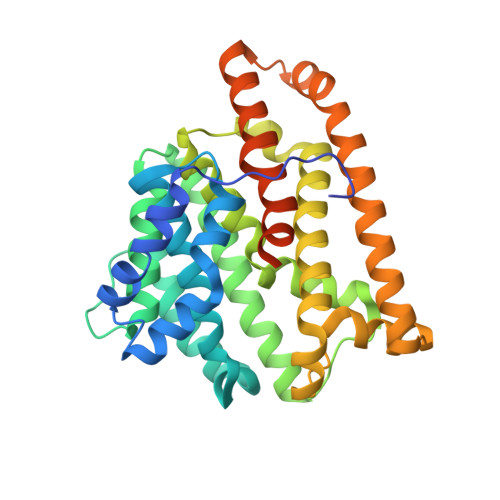Mechanism Underlying Anti-Markovnikov Addition in the Reaction of Pentalenene Synthase.
Matos, J.O., Kumar, R.P., Ma, A.C., Patterson, M., Krauss, I.J., Oprian, D.D.(2020) Biochemistry 59: 3271-3283
- PubMed: 32786410
- DOI: https://doi.org/10.1021/acs.biochem.0c00518
- Primary Citation of Related Structures:
6WKC, 6WKD, 6WKE, 6WKF, 6WKG, 6WKH, 6WKI, 6WKJ - PubMed Abstract:
Most terpene synthase reactions follow Markovnikov rules for formation of high-energy carbenium ion intermediates. However, there are notable exceptions. For example, pentalenene synthase (PS) undergoes an initial anti-Markovnikov cyclization reaction followed by a 1,2-hydride shift to form an intermediate humulyl cation with positive charge on the secondary carbon C9 atom of the farnesyl diphosphate substrate. The mechanism by which these enzymes stabilize and guide the regioselectivity of secondary carbocations has not heretofore been elucidated. In an effort to better understand these reactions, we grew crystals of apo-PS, soaked them with the nonreactive substrate analogue 12,13-difluorofarnesyl diphosphate, and determined the X-ray structure of the resulting complex at 2.2 Å resolution. The most striking feature of the active site structure is that C9 is perfectly positioned to make a C-H···π interaction with the side chain benzene ring of residue F76; this would enhance hyperconjugation to stabilize a developing cation at C10 and thus support the anti-Markovnikov regioselectivity of the cyclization. The benzene ring is also positioned to catalyze the migration of H to C10 and stabilize a C9 carbocation. On the opposite face of C9, further cation stabilization is possible via interactions with the main chain carbonyl of I177 and the neighboring intramolecular C6═C7 bond. Mutagenesis experiments also support a role for residue 76 in these interactions, but most interesting is the F76W mutant, whose crystal structure clearly shows C9 and C10 centered above the fused benzene and pyrrole rings of the indole side chain, respectively, such that a carbocation at either position could be stabilized in this complex, and two anti-Markovnikov products, pentalenene and humulene, are formed. Finally, we show that there is a rough correlation (although not absolute) of an aromatic side chain (F or Y) at position 76 in related terpene synthases from Streptomyces that catalyze similar anti-Markovnikov addition reactions.
- Department of Biochemistry, Brandeis University, Waltham, Massachusetts 02454, United States.
Organizational Affiliation:

















